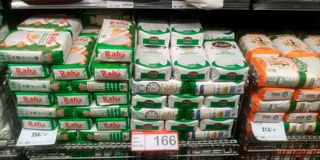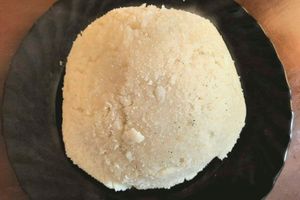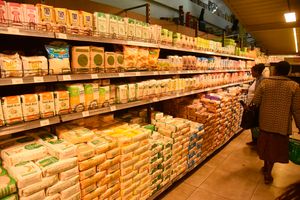
Packets of maize flour on display at Quickmart Supermarket in Kasarani, Nairobi.
Millers raised the price of maize flour a further 2.64 percent in April, amidst a thinning supply of grain because of competition from animal feed manufacturers which prompted an intervention from the Agriculture ministry.
Data collated by the Kenya National Bureau of Statistics (KNBS) shows a two-kilogramme packet of fortified maize flour sold for an average of Sh169.41 in the review month compared with Sh165.05 in March.
Analysis of the KNBS data shows the price of fortified maize flour in April was the highest in 14 months, going back to February 2024 when a two-kilogramme retailed at Sh172.75.
The latest increment means households spent Sh24.77, or 17.13 percent, more to buy maize flour or unga, compared with last October when the cost averaged Sh144.64 per two-kilogramme packet.
“The higher maize prices have strained cash flows, requiring more funds to maintain production capacity. Due to limited grain availability, many millers are operating on reduced schedules,” Paloma Fernandes, chief executive of Cereal Millers Association, told Daily Nation.
“With maize prices continuing to rise, the cost of flour is expected to increase proportionally.”
In a bid to ease competition-induced price pressure on the white variety of maize, Cabinet Secretary for Agriculture Mutahi Kagwe announced in early April that Kenya will allow duty-free importation of 5.5 million bags of yellow maize for production of animal feeds.
"The Ministry of Agriculture notes the growing competition between animal feed millers and maize millers for human consumption over limited maize grain stocks. As a result, the price of a 90-kilogramme bag of maize has risen by approximately 26 percent compared to three months ago," Mr Kagwe wrote in a press statement on April 4.
The rising competition for maize grain, which has prompted millers to look for supply from Tanzania, is happening despite repeated reassurance from President William Ruto that was on track to achieving stability in the domestic food supply.
"The objective is to reduce pressure on local white maize stocks by shifting animal feed millers to yellow maize. This will allow millers focused on human consumption to access available maize at fairer prices, ultimately leading to reduced production costs and more stable unga prices for consumers."
The window allows the shipment of non-GMO yellow maize from outside the seven-nation East African Community trading bloc, imports which will otherwise be slapped with a 50 percent duty.
“Our overarching goal remains to make farming profitable, stabilise farmer incomes, and secure national food security. The reduction of fertiliser prices has led to a 40 percent surge in maize production and boosted farmers’ earnings,” Dr Ruto said on Thursday during the celebrations of International Labour Day in Nairobi.
Kenya endured a steep biting drought in 2022, seen as the worst in four decades, prompting the Treasury to intervene and allow the Agriculture Ministry to waive import duties to smoothen purchase of key raw materials for manufacturing of dairy and chicken feeds.







